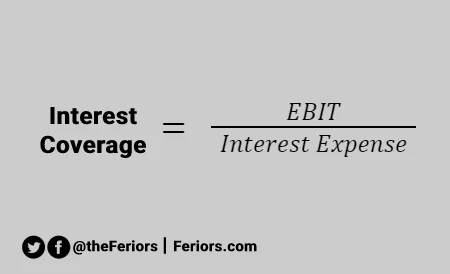What is Interest Coverage Ratio
The interest coverage ratio is a financial ratio that measures the number of available income for interest payments (and other fixed charge obligations). The interest coverage ratio (ICR) is the comparison between the earnings before interests and taxes (EBIT) and the company’s interest expense within a year.
Interest coverage ratio (ICR) value reflects the dollars of operating earnings available to pay for each dollar of interest expense. Thus, the interest coverage ratio value of 1.00 means that the company’s earnings before interests and taxes is available equal to the company’s annual interest expenses.
To put it simply, the interest coverage ratio is a ratio used to determine how many times a company can pay interest from its current EBIT and helps determine a company’s liquidity by calculating how easy it is for the company to pay interest. Essentially, the interest coverage ratio measures the number of times a company can cover its current interest payments using available earnings (the number of times the company has excess or insufficient debt).
Note: The term “coverage” refers to the period of time (a quarter or fiscal year) during which interest can be paid based on the company’s currently available profits.
Interest Coverage Meaning for Investors
Investors use the interest coverage ratio to measure how easy for the company to pay off its debt to determine the company’s creditworthiness. When used consistently, the ICR can reveal trends and provide insight into whether a company needs to revamp internal processes to remain solvent or whether it is at risk of bankruptcy.
Further, the higher the interest coverage ratio, the more equity and less debt the company uses to finance the company’s assets. Thus, the low levels of the company’s debt will dilute the return to stockholders due to increased use of equity and not taking advantage of the tax deductibility by interest expense.
What Is a Good Interest Coverage Ratio?
A good interest coverage ratio number is a higher number. The higher number means that the company has an operating profit of more than $1 to pay every $1 of the company’s interest expenses. A higher ratio indicates better financial health, as it means the company is better able to meet its interest obligations through operating income.
In contrast, the interest coverage ratio is less than 1 shows that the company has less than $1 of the operating profit to pay $1 of interest expenses. To put it simply, the company can’t pay for the interest obligations because the annual interest expenses in more than the operating profit.
A lower ratio indicates that less operating income is available to pay interest and that the company is more vulnerable to interest rate volatility because multiplying the accrued interest ratio could mean the company isn’t ready for growth. This is the reason why a lower ratio might not be attractive to investors.
The higher number of ICR, the higher profits left to repay interest expenses.
Interest Coverage Ratio Formula
The interest coverage ratio can be calculated by dividing the earnings before interests and taxes (EBIT) by the company’s annual interest expenses, or do the following interest coverage ratio formula:
ICR = EBIT / Interest

Where:
- EBIT is income before interests and taxes, also known as the operating profit.
- Interest is annual interest expenses (and other fixed charge obligations).
As you can see from the interest coverage ratio formula, the interest coverage ratio is also known is the Time Interest Earned Ratio.
For example, the company had earnings before interests and taxes of $200,000 and had annual interest expenses of $50,000.
ICR = 200,000 / 50,000 = 4 times
The example company’s interest coverage ratio is 4 times. The company’s earnings before interests and taxes in more than the interest obligations 4 times. In other words, the company has an operating profit of $4 to (EASY) repay every $1 of the company’s interest expenses.
FAQs about the ICR
The interest coverage ratio is a comparison between the EBIT and interest expense to measure the available income for interest payments.
ICR = EBIT / Interest Expenses
A good interest coverage ratio number is a higher number (than 1). The higher number of ICR, the higher profits left to repay interest expenses.



